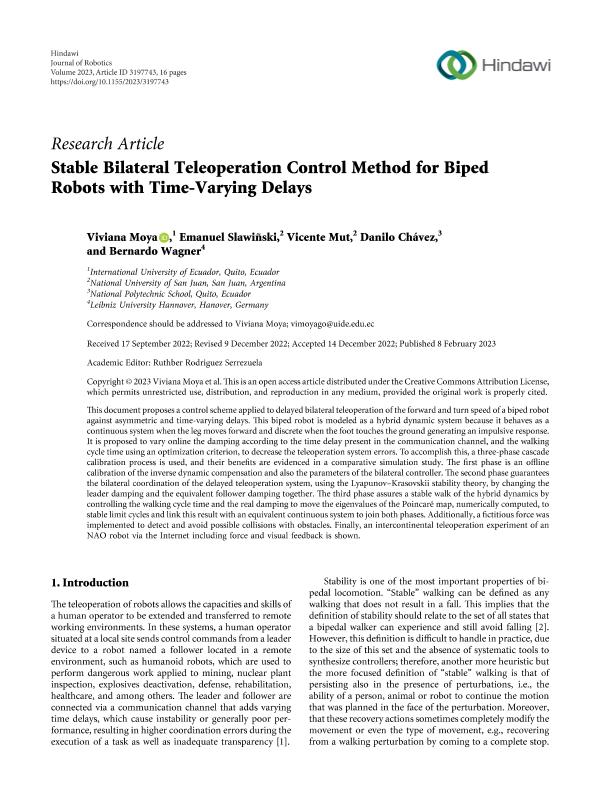Mostrar el registro sencillo del ítem
dc.contributor.author
Moya, Viviana
dc.contributor.author
Slawiñski, Emanuel

dc.contributor.author
Mut, Vicente Antonio

dc.contributor.author
Chávez, Danilo
dc.contributor.author
Wagner, Bernardo
dc.date.available
2024-02-19T11:22:57Z
dc.date.issued
2023-02
dc.identifier.citation
Moya, Viviana; Slawiñski, Emanuel; Mut, Vicente Antonio; Chávez, Danilo; Wagner, Bernardo; Stable Bilateral Teleoperation Control Method for Biped Robots with Time-Varying Delays; Hindawi Publishing Corporation; Journal of Robotics; 2023; 2-2023; 1-16
dc.identifier.issn
1687-9600
dc.identifier.uri
http://hdl.handle.net/11336/227353
dc.description.abstract
This document proposes a control scheme applied to delayed bilateral teleoperation of the forward and turn speed of a biped robot against asymmetric and time-varying delays. This biped robot is modeled as a hybrid dynamic system because it behaves as a continuous system when the leg moves forward and discrete when the foot touches the ground generating an impulsive response. It is proposed to vary online the damping according to the time delay present in the communication channel, and the walking cycle time using an optimization criterion, to decrease the teleoperation system errors. To accomplish this, a three-phase cascade calibration process is used, and their benefits are evidenced in a comparative simulation study. The first phase is an offline calibration of the inverse dynamic compensation and also the parameters of the bilateral controller. The second phase guarantees the bilateral coordination of the delayed teleoperation system, using the Lyapunov-Krasovskii stability theory, by changing the leader damping and the equivalent follower damping together. The third phase assures a stable walk of the hybrid dynamics by controlling the walking cycle time and the real damping to move the eigenvalues of the Poincaré map, numerically computed, to stable limit cycles and link this result with an equivalent continuous system to join both phases. Additionally, a fictitious force was implemented to detect and avoid possible collisions with obstacles. Finally, an intercontinental teleoperation experiment of an NAO robot via the Internet including force and visual feedback is shown.
dc.format
application/pdf
dc.language.iso
eng
dc.publisher
Hindawi Publishing Corporation

dc.rights
info:eu-repo/semantics/openAccess
dc.rights.uri
https://creativecommons.org/licenses/by-nc-sa/2.5/ar/
dc.subject
Biped robot
dc.subject
bilateral teleoperation
dc.subject
time delay
dc.subject
walking robot
dc.subject.classification
Control Automático y Robótica

dc.subject.classification
Ingeniería Eléctrica, Ingeniería Electrónica e Ingeniería de la Información

dc.subject.classification
INGENIERÍAS Y TECNOLOGÍAS

dc.title
Stable Bilateral Teleoperation Control Method for Biped Robots with Time-Varying Delays
dc.type
info:eu-repo/semantics/article
dc.type
info:ar-repo/semantics/artículo
dc.type
info:eu-repo/semantics/publishedVersion
dc.date.updated
2024-02-19T10:19:34Z
dc.identifier.eissn
1687-9619
dc.journal.volume
2023
dc.journal.pagination
1-16
dc.journal.pais
Egipto

dc.journal.ciudad
El Cairo
dc.description.fil
Fil: Moya, Viviana. Universidad Nacional de San Juan. Facultad de Ingeniería. Instituto de Automática; Argentina
dc.description.fil
Fil: Slawiñski, Emanuel. Consejo Nacional de Investigaciones Científicas y Técnicas. Centro Científico Tecnológico Conicet - San Juan. Instituto de Automática. Universidad Nacional de San Juan. Facultad de Ingeniería. Instituto de Automática; Argentina
dc.description.fil
Fil: Mut, Vicente Antonio. Consejo Nacional de Investigaciones Científicas y Técnicas. Centro Científico Tecnológico Conicet - San Juan. Instituto de Automática. Universidad Nacional de San Juan. Facultad de Ingeniería. Instituto de Automática; Argentina
dc.description.fil
Fil: Chávez, Danilo. No especifíca;
dc.description.fil
Fil: Wagner, Bernardo. Leibniz University Hannover; Alemania
dc.journal.title
Journal of Robotics
dc.relation.alternativeid
info:eu-repo/semantics/altIdentifier/doi/https://doi.org/10.1155/2023/3197743
Archivos asociados
